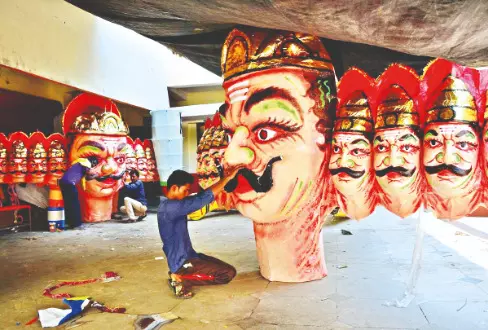From bamboo to ashes: The lives of Delhi’s Ravana artisans

New Delhi: As Dussehra approaches, the skyline of West Delhi transforms. Towering effigies of Ravana, Kumbhakarna and Meghnath rise in open grounds, waiting for the symbolic moment of their destruction. But behind these structures giants stands a community of artisans whose labour, skill and survival remain largely invisible once the flames die down.
Among them is “Delhi ke mashhoor Dulhar Bhai Ravan Wale”, a name whispered with familiarity in lanes filled with bamboo, wires and coloured paper. Dulhar Bhai has been in this craft since 1990, when he was just 13. He recalls learning from the legendary “Ravan Wale Baba,” who pioneered the practice of effigy-making in the capital. “For us, Ravana is not just an effigy it is our livelihood, our identity,” he says.
The craft: From bamboo to flame
The process of making Ravana is nothing short of intricate engineering. It begins with breaking bamboo into strips, which are then tied with wires to form the skeleton of the giant figure. Workers carefully shape the head, limbs,
moustache and body, before turning their attention to the elaborate crown that defines Ravana’s grandeur.
The next stage involves draping the body with a layer of saree cloth, but the face is left bare. Artisans prepare a special glue using araroat (arrowroot flour), which binds layer upon layer of colourful paper onto the structure, creating a vibrant finish. For the face, black and white sheets are layered two to three times, later painted with striking eyes, bold lips and intricate facial features. Each Ravana is a labour of patience, precision and creativity.
Artisans in the shadows
Despite their artistry, the workers mostly daily wagers earn a modest livelihood. “We make more than 2,000 effigies every season in West Delhi,” Dulhar Bhai explains. “But once the festival ends, there is no work. Many of us switch to other odd jobs just to survive.”
The effigies travel far beyond Delhi, to Punjab, Bihar, Gujarat, Assam and Odisha, where they are assembled at Ramleela grounds for the grand Ravana Dahan. Yet, the artists themselves rarely travel with their creations, leaving behind the chance to see their labour admired by thousands.
A fragile tradition
The tradition thrives on community demand, but artisans fear its sustainability. Rising costs of raw materials, shrinking open spaces, and increasing safety regulations around firecrackers pose challenges to their already fragile livelihoods. For many, effigy-making is no longer just an art but a gamble with economic uncertainty.
Still, the pride remains. “When people cheer as Ravana burns, they don’t see us,” says one young worker, wiping glue off his hands. “But we know it is our hands that built the moment.”
As the flames leap skyward this Dussehra, consuming the towering figure of Ravana, the unseen struggles of Delhi’s effigy makers linger in the shadows. Their giants vanish in fire, but their craft and their fight for dignity endures year after year.



